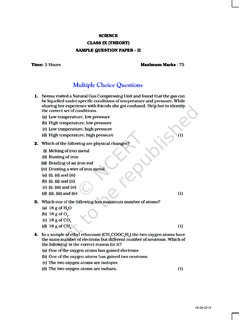Transcription of SEMICONDUCTOR AND SIMPLE CIRCUITSnot to be …
1 INTRODUCTIOND evices in which a controlled flow of electrons can be obtained are thebasic building blocks of all the electronic circuits. Before the discovery oftransistor in 1948, such devices were mostly vacuum tubes (also calledvalves) like the vacuum diode which has two electrodes, viz., anode (oftencalled plate) and cathode; triode which has three electrodes cathode,plate and grid; tetrode and pentode (respectively with 4 and 5 electrodes).In a vacuum tube, the electrons are supplied by a heated cathode andthe controlled flow of these electrons in vacuum is obtained by varyingthe voltage between its different electrodes.
2 Vacuum is required in theinter-electrode space; otherwise the moving electrons may lose theirenergy on collision with the air molecules in their path. In these devicesthe electrons can flow only from the cathode to the anode ( , only in onedirection). Therefore, such devices are generally referred to as vacuum tube devices are bulky, consume high power, operategenerally at high voltages (~100 V) and have limited life and low seed of the development of modern solid-state semiconductorelectronics goes back to 1930 s when it was realised that some solid-state semiconductors and their junctions offer the possibility of controllingthe number and the direction of flow of charge carriers through excitations like light, heat or small applied voltage can changethe number of mobile charges in a SEMICONDUCTOR .
3 Note that the supplyChapter FourteenSEMICONDUCTORELECTRONICS:MATERIA LS, DEVICESAND SIMPLE CIRCUITS NCERT not to be republishedPhysics468and flow of charge carriers in the SEMICONDUCTOR devices are within thesolid itself, while in the earlier vacuum tubes/valves, the mobile electronswere obtained from a heated cathode and they were made to flow in anevacuated space or vacuum. No external heating or large evacuated spaceis required by the SEMICONDUCTOR devices. They are small in size, consumelow power, operate at low voltages and have long life and high the Cathode Ray Tubes (CRT) used in television and computermonitors which work on the principle of vacuum tubes are being replacedby Liquid Crystal Display (LCD) monitors with supporting solid stateelectronics.
4 Much before the full implications of the SEMICONDUCTOR deviceswas formally understood, a naturally occurring crystal of galena (Leadsulphide, PbS) with a metal point contact attached to it was used asdetector of radio the following sections, we will introduce the basic concepts ofsemiconductor physics and discuss some SEMICONDUCTOR devices likejunction diodes (a 2-electrode device) and bipolar junction transistor (a3-electrode device). A few circuits illustrating their applications will alsobe OF METALS, CONDUCTORS ANDSEMICONDUCTORSOn the basis of conductivityOn the basis of the relative values of electrical conductivity ( ) or resistivity( = 1/ ), the solids are broadly classified as:(i)Metals: They possess very low resistivity (or high conductivity).
5 ~ 10 2 10 8 m ~ 102 108 S m 1(ii) semiconductors : They have resistivity or conductivity intermediateto metals and insulators. ~ 10 5 106 m ~ 105 10 6 S m 1(iii)Insulators: They have high resistivity (or low conductivity). ~ 1011 1019 m ~ 10 11 10 19 S m 1 The values of and given above are indicative of magnitude andcould well go outside the ranges as well. Relative values of the resistivityare not the only criteria for distinguishing metals, insulators andsemiconductors from each other. There are some other differences, whichwill become clear as we go along in this interest in this chapter is in the study of semiconductors whichcould be:(i)Elemental semiconductors : Si and Ge(ii)Compound semiconductors : Examples are: Inorganic: CdS, GaAs, CdSe, InP, etc.
6 Organic: anthracene, doped pthalocyanines, etc. Organic polymers: polypyrrole, polyaniline, polythiophene, of the currently available SEMICONDUCTOR devices are based onelemental semiconductors Si or Ge and compound inorganic NCERT not to be republished469 SEMICONDUCTOR Electronics:Materials, Devices andSimple Circuitssemiconductors. However, after 1990, a few SEMICONDUCTOR devices usingorganic semiconductors and semiconducting polymers have beendeveloped signalling the birth of a futuristic technology of polymer-electronics and molecular-electronics.
7 In this chapter, we will restrictourselves to the study of inorganic semiconductors , particularlyelemental semiconductors Si and Ge. The general concepts introducedhere for discussing the elemental semiconductors , by-and-large, applyto most of the compound semiconductors as the basis of energy bandsAccording to the Bohr atomic model, in an isolated atom the energy ofany of its electrons is decided by the orbit in which it revolves. But whenthe atoms come together to form a solid they are close to each other. Sothe outer orbits of electrons from neighbouring atoms would come veryclose or could even overlap.
8 This would make the nature of electron motionin a solid very different from that in an isolated the crystal each electron has a unique position and no twoelectrons see exactly the same pattern of surrounding charges. Becauseof this, each electron will have a different energy level. These differentenergy levels with continuous energy variation form what are calledenergy bands. The energy band which includes the energy levels of thevalence electrons is called the valence band. The energy band above thevalence band is called the conduction band.
9 With no external energy, allthe valence electrons will reside in the valence band. If the lowest level inthe conduction band happens to be lower than the highest level of thevalence band, the electrons from the valence band can easily move intothe conduction band. Normally the conduction band is empty. But whenit overlaps on the valence band electrons can move freely into it. This isthe case with metallic there is some gap between the conduction band and the valenceband, electrons in the valence band all remain bound and no free electronsare available in the conduction band.
10 This makes the material aninsulator. But some of the electrons from the valence band may gainexternal energy to cross the gap between the conduction band and thevalence band. Then these electrons will move into the conduction the same time they will create vacant energy levels in the valence bandwhere other valence electrons can move. Thus the process creates thepossibility of conduction due to electrons in conduction band as well asdue to vacancies in the valence us consider what happens in the case of Si or Ge crystal containingN atoms.










